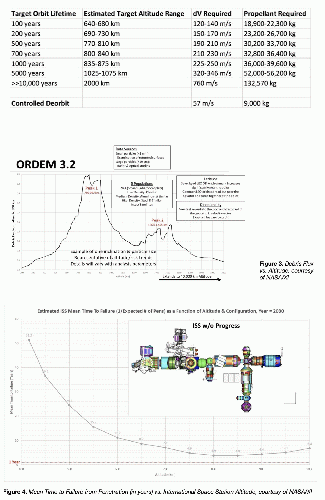NASA has released the following charts relating to its plan to de-orbit the International Space Station in 2030, and even commission SpaceX to carry that out. They claim there are no other viable options. You can read a summary of their analysis here.

NASA Charts showing technical requirements for increasing the orbital distance of the ISS, or for de-orbiting it.
(Image by NASA) Details DMCA
The lowest Target Orbital Lifetime of 100 years on the chart is just ~2X
the delta V and propellant required to de-orbit the ISS and crash it - it is
hoped, harmlessly - into the southern Pacific Ocean.
100 years is just a bit less than the entire history of mechanized
flight of ANY kind, and space flight is now more than half of that period. The
floundering of manned spaceflight after Apollo is really obvious and
inexcusable.
And it's not even entirely true. The Hubble telescope is 326 miles or 547 kilometers from Earth, yet it was successfully repaired AFTER reaching orbit by the lowly and often-maligned Space Shuttle. 547km is just 93km-133km below the lowest 100yr orbital target in the chart, and a, say, 50yr orbital target, not charted, would probably be within current technological capabilities and fuel capacities, even with the clearly inferior - for this task - SpaceX Starship carrying enough fuel in a planned booster rocket or at least one that could transfer fuel to the ISS's own booster system. Is NASA saying that in 50-100 years they won't have the capability to boost the ISS again, incorporate it into a larger space station, or even safely disassemble in from a depot in space, possibly with AI controlled robots? The later Star Trek shows & films used AI bots to assemble and repair space-docked (real) Starships. Does NASA's own evolution and imagination stop at just NAMING a Space Shuttle Enterprise or can real starships and the space stations to support them still be envisioned by NASA?
At the same time as such defeatist, pedestrian, options are provided for the ISS, there are ambitious yet realistic plans for the first atomic rockets from both NASA and private industry, before the end of this decade. Surely, within a 50yr orbital target, these will be feasible, manned or "botted" with AI robots that can make necessary repairs, disassembly, reuse, of the ISS in a larger space station setup. This concept has been insufficiently explored because we, as a nation, even as a species, no longer consider challenging great projects requiring great co-operation (unmentioned is the semi-permanent breakdown of Russian-American co-operation and even the possibility of thermonuclear war ending a lot more than the space program; this is just "accepted" as the background conditions for the NASA's analysis).
Also unmentioned and maybe even unexamined, is the pollution and ecological damage of throwing a nearly 1 million pound object into the ocean, even assuming something that large can ever be successfully guided to a watery crash, and any ensuing tsunami controlled as well. The history of SpaceX's first attempts at anything flown into orbit is not inspiring - 2 blowups of the first 2 Starships, for example - even if their overall track record might be evolutionarily inspiring.
Some bean counters are behind this, not anyone with vision, which is apparently in another department at NASA.





